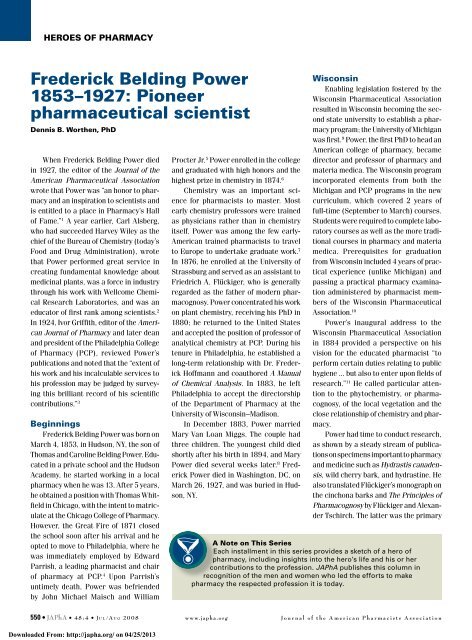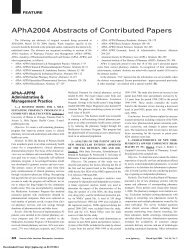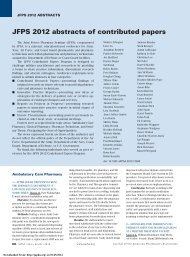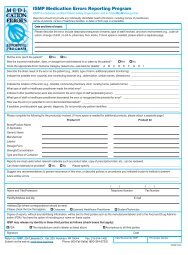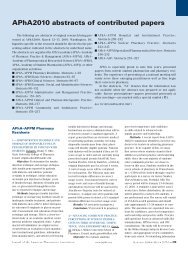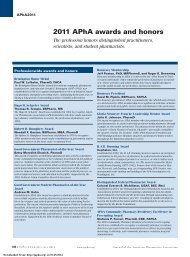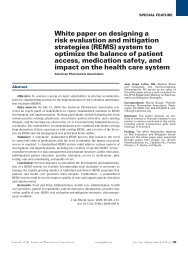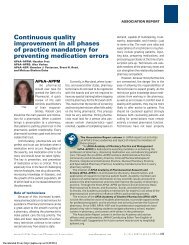frederick Belding power 1853–1927: pioneer pharmaceutical scientist
frederick Belding power 1853–1927: pioneer pharmaceutical scientist
frederick Belding power 1853–1927: pioneer pharmaceutical scientist
Create successful ePaper yourself
Turn your PDF publications into a flip-book with our unique Google optimized e-Paper software.
Heroes of pHarmacy<br />
<strong>frederick</strong> <strong>Belding</strong> <strong>power</strong><br />
<strong>1853–1927</strong>: <strong>pioneer</strong><br />
<strong>pharmaceutical</strong> <strong>scientist</strong><br />
Dennis B. Worthen, phD<br />
When Frederick <strong>Belding</strong> Power died<br />
in 1927, the editor of the Journal of the<br />
American Pharmaceutical Association<br />
wrote that Power was “an honor to pharmacy<br />
and an inspiration to <strong>scientist</strong>s and<br />
is entitled to a place in Pharmacy’s Hall<br />
of Fame.” 1 A year earlier, Carl Alsberg,<br />
who had succeeded Harvey Wiley as the<br />
chief of the Bureau of Chemistry (today’s<br />
Food and Drug Administration), wrote<br />
that Power performed great service in<br />
creating fundamental knowledge about<br />
medicinal plants, was a force in industry<br />
through his work with Wellcome Chemical<br />
Research Laboratories, and was an<br />
educator of first rank among <strong>scientist</strong>s. 2<br />
In 1924, Ivor Griffith, editor of the American<br />
Journal of Pharmacy and later dean<br />
and president of the Philadelphia College<br />
of Pharmacy (PCP), reviewed Power’s<br />
publications and noted that the “extent of<br />
his work and his incalculable services to<br />
his profession may be judged by surveying<br />
this brilliant record of his scientific<br />
contributions.” 3<br />
Beginnings<br />
Frederick <strong>Belding</strong> Power was born on<br />
March 4, 1853, in Hudson, NY, the son of<br />
Thomas and Caroline <strong>Belding</strong> Power. Educated<br />
in a private school and the Hudson<br />
Academy, he started working in a local<br />
pharmacy when he was 13. After 5 years,<br />
he obtained a position with Thomas Whitfield<br />
in Chicago, with the intent to matriculate<br />
at the Chicago College of Pharmacy.<br />
However, the Great Fire of 1871 closed<br />
the school soon after his arrival and he<br />
opted to move to Philadelphia, where he<br />
was immediately employed by Edward<br />
Parrish, a leading pharmacist and chair<br />
of pharmacy at PCP. 4 Upon Parrish’s<br />
untimely death, Power was befriended<br />
by John Michael Maisch and William<br />
550 • JAPhA • 48:4 • Ju l /Au g 2008<br />
Downloaded From: http://japha.org/ on 04/25/2013<br />
Procter Jr. 5 Power enrolled in the college<br />
and graduated with high honors and the<br />
highest prize in chemistry in 1874. 6<br />
Chemistry was an important science<br />
for pharmacists to master. Most<br />
early chemistry professors were trained<br />
as physicians rather than in chemistry<br />
itself. Power was among the few early-<br />
American trained pharmacists to travel<br />
to Europe to undertake graduate work. 7<br />
In 1876, he enrolled at the University of<br />
Strassburg and served as an assistant to<br />
Friedrich A. Flückiger, who is generally<br />
regarded as the father of modern pharmacognosy.<br />
Power concentrated his work<br />
on plant chemistry, receiving his PhD in<br />
1880; he returned to the United States<br />
and accepted the position of professor of<br />
analytical chemistry at PCP. During his<br />
tenure in Philadelphia, he established a<br />
long-term relationship with Dr. Frederick<br />
Hoffmann and coauthored A Manual<br />
of Chemical Analysis. In 1883, he left<br />
Philadelphia to accept the directorship<br />
of the Department of Pharmacy at the<br />
University of Wisconsin–Madison.<br />
In December 1883, Power married<br />
Mary Van Loan Miggs. The couple had<br />
three children. The youngest child died<br />
shortly after his birth in 1894, and Mary<br />
Power died several weeks later. 8 Frederick<br />
Power died in Washington, DC, on<br />
March 26, 1927, and was buried in Hudson,<br />
NY.<br />
www.japha.org<br />
Wisconsin<br />
Enabling legislation fostered by the<br />
Wisconsin Pharmaceutical Association<br />
resulted in Wisconsin becoming the second<br />
state university to establish a pharmacy<br />
program; the University of Michigan<br />
was first. 9 Power, the first PhD to head an<br />
American college of pharmacy, became<br />
director and professor of pharmacy and<br />
materia medica. The Wisconsin program<br />
incorporated elements from both the<br />
Michigan and PCP programs in the new<br />
curriculum, which covered 2 years of<br />
full-time (September to March) courses.<br />
Students were required to complete laboratory<br />
courses as well as the more traditional<br />
courses in pharmacy and materia<br />
medica. Prerequisites for graduation<br />
from Wisconsin included 4 years of practical<br />
experience (unlike Michigan) and<br />
passing a practical pharmacy examination<br />
administered by pharmacist members<br />
of the Wisconsin Pharmaceutical<br />
Association. 10<br />
Power’s inaugural address to the<br />
Wisconsin Pharmaceutical Association<br />
in 1884 provided a perspective on his<br />
vision for the educated pharmacist “to<br />
perform certain duties relating to public<br />
hygiene ... but also to enter upon fields of<br />
research.” 11 He called particular attention<br />
to the phytochemistry, or pharmacognosy,<br />
of the local vegetation and the<br />
close relationship of chemistry and pharmacy.<br />
Power had time to conduct research,<br />
as shown by a steady stream of publications<br />
on specimens important to pharmacy<br />
and medicine such as Hydrastis canadensis,<br />
wild cherry bark, and hydrastine. He<br />
also translated Flückiger’s monograph on<br />
the cinchona barks and The Principles of<br />
Pharmacognosy by Flückiger and Alexander<br />
Tschirch. The latter was the primary<br />
a Note on This series<br />
Each installment in this series provides a sketch of a hero of<br />
pharmacy, including insights into the hero’s life and his or her<br />
contributions to the profession. JAPhA publishes this column in<br />
recognition of the men and women who led the efforts to make<br />
pharmacy the respected profession it is today.<br />
Journal of the American Pharmacists Association
source for this basic <strong>pharmaceutical</strong> science<br />
for decades. The pharmacy program<br />
continued at a steady pace, with enrollment<br />
increasing from 27 to 63 during<br />
the 1891–1892 school year. 12 Power’s<br />
laboratory work with students was productive<br />
and of high quality. 7 Power delivered<br />
the 1893 graduation address, during<br />
which he spoke of the role of scientific<br />
and technical knowledge imparted by a<br />
pharmacy education and argued that this<br />
was the way to weed out incompetents so<br />
that “the quacks, the pettifoggers would<br />
disappear.” 13 In addition to his teaching<br />
and research at the university, Power<br />
also contributed the lessons in chemistry<br />
and physics to a series under the title<br />
National Institute of Pharmacy, published<br />
by G.P. Engelhard and the Western Druggist.<br />
This early distance-learning program<br />
was instituted by Carl Hallberg and<br />
other faculty from the Chicago College of<br />
Pharmacy. 14<br />
Power resigned from the University<br />
of Wisconsin in 1892 because of inadequate<br />
salary. 9 He accepted the position<br />
of Scientific Director for Fritzsche Brothers,<br />
which was the American branch of<br />
Schimmel & Company of Leipzig, Germany.<br />
Flückiger had worked with Schimmel,<br />
which may well have been a factor<br />
in Power’s acceptance of the position.<br />
In his 4 years with the company, Power<br />
published a series of studies dealing with<br />
essential oils important to pharmacists<br />
and the perfumers’ art, including oils<br />
of wintergreen, bay, peppermint, and<br />
clove.<br />
Wellcome chemical<br />
research Laboratories<br />
In 1896, the industrial pharmacist<br />
Henry Wellcome established his chemical<br />
research laboratories in London and<br />
convinced his old PCP classmate, Power,<br />
to accept the position as its first director.<br />
Wellcome stated that he had made<br />
the “most important, single appointment<br />
so far in the history of Burroughs<br />
Wellcome—that of Frederick Power as<br />
the firm’s chief scientific chemist and<br />
researcher into the unknown.” 15 At the<br />
dinner for Power at the opening of the<br />
Heroes of pHarmacy<br />
Frederick <strong>Belding</strong> Power (<strong>1853–1927</strong>) in his phytochemical laboratory, 1916–1919, at<br />
the Bureau of Chemistry in the U.S. Department of Agriculture. In 1924, he was the first<br />
pharmacist elected to the National Academy of Sciences.<br />
laboratories, Wellcome noted that the<br />
work would be “entirely separate and<br />
distinct from all their business departments<br />
... The work would be carried out<br />
on no selfish lines. It would be controlled<br />
and dictated with the highest regard<br />
for science.” 16 The laboratories started<br />
slowly, and initial efforts were directed<br />
at production and quality control for the<br />
manufacturing plant. 17 By 1899, however,<br />
Power was in his own building with a staff<br />
of more than 20. 18<br />
Wellcome had a long-standing interest<br />
in tropical disease. Chaulmoogra oil<br />
had a long tradition of use for leprosy, and<br />
in 1904, Power undertook a study to identify<br />
the source of the oil and its chemical<br />
makeup. Three trees were identified as<br />
sources of chaulmoogric acid and hydnocarpic<br />
acid, which became the major<br />
treatments for leprosy until the advent of<br />
sulfones in the 1940s. 19<br />
Power and the Chemical Research<br />
Laboratories exhibited results of its work<br />
Journal of the American Pharmacists Association www.pharmacist.com J u l /Au g 2008 • 48:4 • JAPhA • 551<br />
Downloaded From: http://japha.org/ on 04/25/2013
Heroes of pHarmacy<br />
in a number of international expositions.<br />
From 1904 through 1911, the exhibitions<br />
won medals in St. Louis, MO (1904);<br />
Liège, Belgium (1905); Milan, Italy,<br />
and London (1906); Brussels, Belgium<br />
(1910); and Turin, Italy (1911). 5<br />
Power’s research was interrupted<br />
when World War I began. 20 Power had<br />
passed his 60th birthday and wanted to<br />
be closer to family; he resigned from the<br />
laboratories and returned to the United<br />
States in December 1914. 21 In the period<br />
in which he directed the laboratories,<br />
168 papers covering a wide range of topics<br />
were published 18 ; 75 of these were<br />
authored or coauthored by Power—a<br />
“record of accomplishment in <strong>pharmaceutical</strong><br />
and plant chemistry that is<br />
almost without parallel.” 5<br />
american <strong>pharmaceutical</strong><br />
association<br />
Power joined the American Pharmaceutical<br />
(now Pharmacists) Association<br />
(APhA) in 1872; his application was<br />
signed by his professors at PCP, Edward<br />
Parrish and John Maisch. 6 His thesis on<br />
Podophyllum was originally published in<br />
the American Journal of Pharmacy. He<br />
returned to this line of inquiry while in<br />
Strassburg, and the resulting publication<br />
in the Proceedings of the American Pharmaceutical<br />
Association was awarded the<br />
Ebert Prize for publication of scientific<br />
research in 1877. Power received two<br />
additional Ebert prizes, one in 1903 for<br />
his work on Derris uliginosa and another<br />
in 1907 for Eriodictyon. When the report<br />
on Derris—an East Indian fish poison<br />
that gained usage as an insecticide—was<br />
introduced, Power was identified as an<br />
active, foreign member of the Association<br />
whose research was praised as “very full<br />
in every respect.” 22<br />
product standards<br />
Therapeutics and materia medica of<br />
the late 19th and early 20th centuries<br />
were dominated by botanical products;<br />
in 1900, more than 50% of the items in<br />
the United States Pharmacopoeia (USP)<br />
remained botanical in origin. 23 The challenge<br />
for pharmacists and manufacturers<br />
552 • JAPhA • 48:4 • Ju l /Au g 2008<br />
Downloaded From: http://japha.org/ on 04/25/2013<br />
alike was the standardization of products.<br />
The responsibility for establishing standards<br />
in the United States had devolved<br />
to USP, which was revised on a decennial<br />
basis. In 1890, Power served on the USP<br />
Committee of Revision and was responsible<br />
for a large part of the work. 6<br />
By the 1900 USP revision, Power<br />
was in London at the Wellcome Chemical<br />
Research Laboratories. His interest in<br />
standards was evident in his comments<br />
on the newest edition of the British Pharmacopoeia.<br />
He reviewed the chemistry<br />
components, concluded that there were<br />
far more errors than appropriate for such<br />
a work, and offered a series of suggestions<br />
to address the more troublesome<br />
problems. 24 In 1902, he represented the<br />
United States at the International Conference<br />
for the Unification of Formulae<br />
of Potent Medicines in Brussels and<br />
reported on the success of the deliberations<br />
and recommendations. 25 In 1920,<br />
Power was elected as the first vice president<br />
of the USP Convention, reflecting his<br />
return to the United States and influence<br />
within the Department of Agriculture.<br />
Department of agriculture<br />
When Power returned to the United<br />
States in 1914, he was 60 years old but<br />
far from ready to retire permanently.<br />
After a long rest, Power completed the<br />
requirements and accepted the post of<br />
director of the newly formed phytochemical<br />
laboratory in the Bureau of Chemistry<br />
of the United States Department of Agriculture.<br />
26 In 1916, he articulated the purpose<br />
of the laboratory, noting the need to<br />
explore native plants, not only for scientific<br />
interest but also for “the considerable<br />
number of substances which would<br />
be found to possess medicinal value.” 27<br />
Power continued a productive<br />
research career and remained with the<br />
bureau after the mandatory retirement<br />
age of 70. In reflecting on Power’s work,<br />
Carl Alsberg remarked that “he soon<br />
became one of the strongest influences<br />
in the bureau for fostering that sound<br />
scholarship and research spirit.” 2<br />
www.japha.org<br />
Honors and legacy<br />
In 1908, the University of Wisconsin<br />
awarded Power an honorary doctor of<br />
laws degree, and in 1913, his alma mater,<br />
PCP, conferred the honorary degree of<br />
master in pharmacy. In 1913, the Pharmaceutical<br />
Society of London awarded<br />
Power the Hanbury Medal. He was only<br />
the second American to receive the<br />
award, the first being German-born John<br />
Michael Maisch; he earlier joined pharmacognosists<br />
Flückiger and Tschirch<br />
in being honored for high excellence in<br />
the promotion of original research in the<br />
natural history and chemistry of drugs. In<br />
1921, Wellcome presented a gold medal<br />
to Power for his services as the director<br />
of the Chemical Laboratories. The presentation<br />
was made by the Secretary of<br />
the Smithsonian Institution, Charles Wolcott,<br />
who remarked on Power’s research<br />
ability and his influence “in raising the<br />
standards of our pharmacopoeias.” 28 In<br />
1922, the Swiss Pharmaceutical Society<br />
presented Power with the Flückiger Gold<br />
Medal. 5 In 1924, he was elected a member<br />
of the National Academy of Sciences,<br />
the first from the Bureau of Chemistry<br />
and probably the first pharmacist so<br />
honored.<br />
In a personal memorial of Power, Louise<br />
Power Heimke described her father<br />
“as a boy shy and sensitive; in manhood<br />
combining a gentle, sympathetic, and<br />
kindly nature with virility and strength<br />
of character, he shed about him a benign<br />
and helpful influence.” 29 Power was a prototype<br />
for the generations of <strong>pharmaceutical</strong><br />
<strong>scientist</strong>s who followed—“One of the<br />
greatest scientific men growing out of the<br />
ranks of American pharmacy.” 7 His thorough<br />
research and writing established<br />
standards of excellence in all areas of<br />
endeavor—academia, industry, and public<br />
service.<br />
Dennis B. Worthen, PhD<br />
Lloyd Scholar<br />
Lloyd Library and Museum<br />
Cincinnati, OH<br />
doi: 10.1331/JAPhA.2008.08527<br />
The author gratefully acknowledges Glenn<br />
Sonnedecker and John Parascandola<br />
for their reviews of this article.<br />
Journal of the American Pharmacists Association
The images used in this article are from the<br />
APhA Foundation Archives and were<br />
selected by George Griffenhagen.<br />
references<br />
1. Anonymous. Obituary: Dr. Frederick<br />
<strong>Belding</strong> Power. J Am Pharm Assoc.<br />
1927;16:380–1.<br />
2. Alsberg CL. Frederick <strong>Belding</strong> Power.<br />
Industrial and Engineering Chemistry.<br />
1926;18:103.<br />
3. Griffith I. A half century of research in<br />
plant chemistry: a chronological record<br />
of the scientific contributions of<br />
Frederick <strong>Belding</strong> Power. Am J Pharm.<br />
1924;96:601–14.<br />
4. Worthen DB. Edward Parrish<br />
(1822–1872): <strong>pioneer</strong> ethicist. J Am<br />
Pharm Assoc. 2005;45:758–61.<br />
5. Browne CA. Frederick <strong>Belding</strong> Power.<br />
J Assoc Official Agricultural Chemists.<br />
1928;11(2):iii–vi.<br />
6. Eberle EG. Frederick <strong>Belding</strong> Power<br />
PhD, LLD, FCS. J Am Pharm Assoc.<br />
1922;11:403–5.<br />
7. Sonnedecker G. The scientific background<br />
of chemistry teachers in representative<br />
pharmacy schools of the United<br />
States in the 19th century. Chymia.<br />
1953;4:171–200.<br />
8. Heimke LP. Notes upon the life and<br />
achievements of Frederick <strong>Belding</strong><br />
Power by his daughter. In: Kremers<br />
Reference Files. American Institute of<br />
the History of Pharmacy, University of<br />
Wisconsin–Madison. 1927;A2 File:18.<br />
9. Kremers E. Dr. Power at Wisconsin.<br />
Badger Pharm. 1936;(no. 13):1–13.<br />
10. Buckner C, Connors KA, Parascandola<br />
J, et al. The University of Wisconsin<br />
School of Pharmacy: its first century.<br />
Madison, WI: Office of University Publications;<br />
1997:13–32.<br />
11. Power FB. The development of chemistry<br />
and its relation to pharmacy. Proceedings<br />
of the Wisconsin Pharmaceutical<br />
Association. 1884:49–55.<br />
12. Buckner C, Connors KA, Parascandola<br />
J, et al. The University of Wisconsin<br />
School of Pharmacy: its first century.<br />
Madison, WI: Office of University Publications;<br />
1997:199.<br />
13. Power FB. The mission of <strong>pharmaceutical</strong><br />
schools. Pharm Rundsch.<br />
1893;11:258–9.<br />
14. Kremers E, Urdang G. History of pharmacy.<br />
2nd ed. Philadelphia: J.B. Lippincott;<br />
1951:300–1.<br />
15. James RR. Henry Wellcome. London:<br />
Hodder & Stoughton; 1994:188.<br />
16. Wellcome H. Dinner given to Dr. Frederick<br />
B. Power on the occasion of the<br />
founding of the Wellcome Chemical Research<br />
Laboratories. London: The Wellcome<br />
Chemical Research Laboratories;<br />
1900:[2–3 of unpaginated section].<br />
17. James RR. Henry Wellcome. London:<br />
Hodder & Stoughton; 1994:207.<br />
18. Parascandola J. Chemistry and commerce:<br />
F.B. Power and the Wellcome<br />
Chemical Research Laboratories.<br />
Pharm Hist (Lond). 2005;35:54–8.<br />
19. Parascandola J. Chaulmoogra oil and<br />
the treatment of leprosy. Pharm Hist.<br />
2003;45:47–57.<br />
Miles Canyon • Whitehorse, Yukon Territory • July 3, 2007 • Cathy Keil<br />
Heroes of pHarmacy<br />
20. Phillips M. Frederick <strong>Belding</strong> Power, most<br />
distinguished American phytochemist.<br />
J Chem Educ. 1954;31:258–61.<br />
21. James RR. Henry Wellcome. London:<br />
Hodder & Stoughton; 1994:326.<br />
22. Caspari C. Introduction. Proceedings of<br />
the American Pharmaceutical Association.<br />
1902;50:296, 332.<br />
23. Flannery MA. For a “voluptuous glow<br />
of health and vigor”: medical botany<br />
in Kentucky, 1792-1910. J Ky Acad Sci.<br />
1999;60:15–30.<br />
24. Power FB. Some observations and suggestions<br />
relating to the chemistry of the<br />
British Pharmacopoeia. London: Wellcome<br />
Chemical Research Laboratories.<br />
1900;(no. 12):1–24.<br />
25. Power FB. The International Conference<br />
for the Unification of Formulae<br />
of Potent Medicaments. Am J Pharm.<br />
1903;75:1–13.<br />
26. Heimke LP. Notes upon the life and<br />
achievements of Frederick <strong>Belding</strong><br />
Power by his daughter. In: Kremers<br />
Reference Files. American Institute of<br />
the History of Pharmacy, University of<br />
Wisconsin–Madison. 1927;A2 File:38.<br />
27. Power FB. The aims and developments<br />
of phytochemical research. Am J<br />
Pharm. 1917;89:97–110.<br />
28. Anonymous. Presentation to Dr.<br />
Frederick <strong>Belding</strong> Power. Science.<br />
1921;NS53:570–1.<br />
29. Heimke LP. Notes upon the life and<br />
achievements of Frederick <strong>Belding</strong><br />
Power by his daughter. In: Kremers<br />
Reference Files. American Institute of<br />
the History of Pharmacy, University of<br />
Wisconsin–Madison. 1927;A2 File:53.<br />
Journal of the American Pharmacists Association www.pharmacist.com J u l /Au g 2008 • 48:4 • JAPhA • 553<br />
Downloaded From: http://japha.org/ on 04/25/2013


